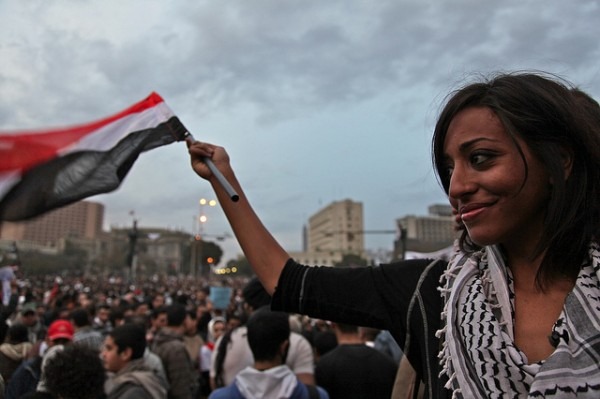I am so fucking scared of the moment a lieutenant or a general would say enough of this rubbish and we are back at military rule completely. It is in their interest for this to disintegrate into chaos, it is in their interest to say ‘you people enough! law and order!’”
So says Mona Anis, activist and author during a July 8, 2011, Tahrir Square protest. Her prescient and painful observation about what is unfolding in Egypt today is captured in Jehane Noujaim’s powerful documentary The Square.
After toppling heads of state, writing two constitutions and changing six governments in just under three years following the Egyptian revolution, many of the country’s revolutionaries are back to square one. But it is not quite the same square we occupied for 18 days in 2011 when the government of Hosni Mubarak was overthrown.
In today’s square, if you are not hailing General Abdel Fattah al-Sisi (who is now pursuing the presidency), you are accused of “belonging to a terrorist organization” also known as “the dissolved outlawed group” or the “traitors”—the Muslim Brotherhood.
The Brotherhood did its part in delivering Egypt into this situation, advancing its candidate, President Mohamed Morsi, who ignored his critics and failed on all accounts to deliver the minimum promised. Yet nothing the Brotherhood has ever done could justify what was done to Magdy Ashour, one of six activists documented in The Square. Because of his political affiliation, Ashour was subjected to repeated detention and torture under Mubarak and now endures house arrest under Al Sisi—a fate shared by many young men in the Brotherhood.
Noujaim’s Oscar-nominated film provides a glimpse into how the revolution evolved over its first two-and-a-half years.
Noujaim’s Oscar-nominated film provides a glimpse into how the revolution evolved over its first two-and-a-half years, following six individuals representing different ideological interests and arguments. Yet The Square represents only the first phase of the revolution, which sadly has been defeated since the July 3, 2013, military coup that followed mass protests that removed Morsi from power.
I took part in the removal of Morsi because of his failure, his empty promises, and his responsibility for the killings of protestors in Ittihadiya, and the violent clashes at the Presidential Palace and Port Said in 2012. We believed we had sacrificed too much to settle for incompetence, and that the power of the people is greater than any dictator even if he was democratically elected.
However, toppling Morsi didn’t mean a blank check for the military to take power, commit massacres, jail thousands, instate curfews, reinstate emergency laws, pass anti-protest laws, or adopt a road map that didn’t adhere to the people’s demands of the original January 25 revolution, or the will of those 22 million Egyptians who signed the anti-Morsi Tamarod petition in June 2013.
At a dark moment in my country—with an estimated 21,000 political detainees and 3,000 dead in just six months following the removal of Morsi and the July 3, 2013, coup (according to Wiki Thawra)—The Square returns us to Tahrir and the beginning of a revolution that not only inspired other revolutions in the Arab world in Yemen, Bahrain, Libya, and Syria, but the entire world: Wisconsin, Trafalgar Square, Catalonia Square, Syntagma Square, Zuccotti Park and most recently the Maidan in Kiev.
Those 18 days shook the world and reinvigorated the idea that people power is greater than those in power. If we have learned anything in the past three years, it is that revolutions do not end in 18 days nor in 18 months. Not even in a couple of years. They require time and organization, in effect, much more than a square and people gathering in it.
Looking back at the three rounds we have fought against Mubarak, the Supreme Council of the Armed Forces under General Tantawi, and the failed presidency of Mohamed Morsi, it is only natural to assume that any current or future leader who fails to deliver what the people demand will face the same fate as his predecessors.
But it is not that simple.
Squares are not just physical places. They are an idea that becomes a state of mind. One of the lessons we must learn is that unless Tahrir is taken to our cities, councils, factories, universities, where alternative systems of democratic power can be organized and nurtured, then the idea of a revolution in a public square may become our very own limitation to freedom.
Gigi Ibrahim (pictured above) was in Tahrir Square in 2011. She was featured on the cover of Time as one of the young leaders of the 2011 Egyptian Revolution. She belongs to the Revolutionary Socialists Movement, lives in Cairo and blogs at theangryegyptian.wordpress.com.







0 Comments